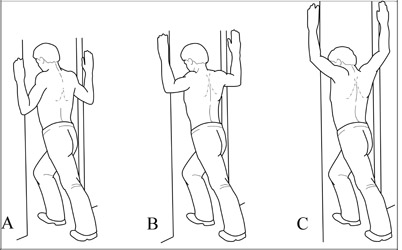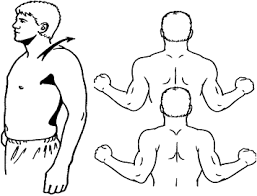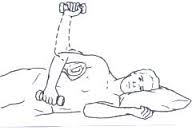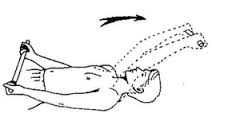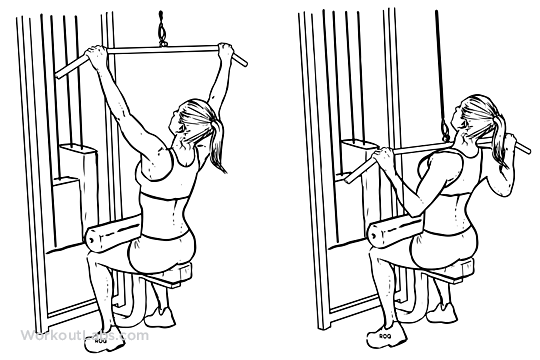As a follow-up to our previous entry on the importance of good posture, we would like to introduce some basic exercises to help restore and maintain normal and optimal posture.
Please note that exercise should be cleared with a physician or physical therapist before beginning any new exercise routine. These exercises should not be painful. If you have pain with any exercise that feels like more than just a stretch please stop and consult a physician or physical therapist.
- Peck door stretch: this stretch is to facilitate optimal shoulder positioning by lessening the tension of the muscles and tendons in the front of the shoulder.
While standing in a doorway. Place hands in the lowest position shown in the picture. Look straight ahead and take a small step forward with one foot until you feel a stretch. You should feel this in your shoulders and chest. Hold for 20 seconds and do this 3 times. Next repeat this for the middle position followed by the highest position. Repeat: 3 Times Hold: 20 Seconds Complete: 1 Set Perform: 1 time per day
2. Shoulder blade squeezing (scapular retraction): this exercise can be performed all throughout the day as mentioned in the previous article. This is what is called a submaximal movement which means you do not need to pull with all of your might. It is just about getting your shoulder blades closer together and using the muscles that control the shoulder blades to do so.
Retract shoulders back, squeezing shoulder blades together. Holding each repetition for 1 second. This exercise can be done up to 300 times per day.
3. Side lying external rotation: this exercise is to help strengthen the muscles that rotate the shoulder to the outside thus putting it in a better position within the joint.
Lie on uninvolved side with the involved shoulder lying on folded towel at side – Keep the elbow bent and arm against towel throughout this exercise. – Lift your wrist and forearm away from your abdomen. Slowly lower – Perform this motion only to a point that is pain-free. Repeat: 20 Times Hold: 2 Seconds Complete: 1 Set Perform: 1 Time Per Day
4. Supine stick flexion: this is a shoulder range of motion exercise that helps to increase the mobility of the shoulder joint as well as the flexibility of the peck muscles and the latissimus dorsi muscles.
While lying on your back on a firm surface, grasp stick with both hands. Push the stick with the uninvolved side toward the involved side. Hold 10 seconds; relax; repeat. Repeat: 10 Times Hold: 10 Seconds Complete: 1 Set Perform: 1 Time Per Day
5. Deep cervical neck flexor stretch: A common product of sitting for work or having an overall poor upper body posture is tightness in the muscles in the front of the neck. This stretch is to allow for more flexibility to allow the head to be in a more retracted position with less strain.
 Place your hands overlapping on your breast bone. Next, tilt you head upwards and away from the affected side until a gentle stretch is felt along the front and side of your neck. Repeat: 5 Times Hold: 10 Seconds Complete: 1 Set Perform: 1 Time Per Day
Place your hands overlapping on your breast bone. Next, tilt you head upwards and away from the affected side until a gentle stretch is felt along the front and side of your neck. Repeat: 5 Times Hold: 10 Seconds Complete: 1 Set Perform: 1 Time Per Day
Exercises six and seven are two that should be completed only in the gym setting and should be completed by the direction of a personal trainer if you are unsure of how these machines work.
6. The low row machine: Not to be confused with the rowing ergometer, this is a higher level exercise to strengthen the periscapular muscles to increase the muscle tone and facilitate an optimal shoulder position.
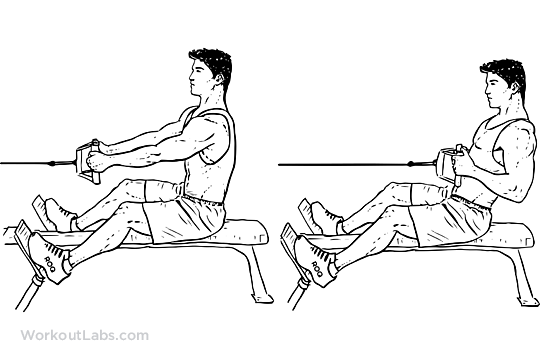 Set machine to appropriate weight. Grabbing handles, pull back squeezing your shoulder blades together at end range. Return to start position and repeat. Machine style may vary depending on gym. Repeat: 10 Times Hold: 1 Second Complete: 3 Sets Perform: 2 Times Per Week
Set machine to appropriate weight. Grabbing handles, pull back squeezing your shoulder blades together at end range. Return to start position and repeat. Machine style may vary depending on gym. Repeat: 10 Times Hold: 1 Second Complete: 3 Sets Perform: 2 Times Per Week
7. Lat pulldown machine: this machine will increase the strength of the latissimus dorsi muscle, which is a major muscle for scapular depression to allow for better positioning as well as better control of the shoulder blades during overhead movement.
Start out by letting your arms and shoulders relax, letting the machine pull your arms up. (when using light weight only). Then by using your shoulder blades; draw them down and back as if to put them in your back pockets. Initiate elbow flexion, pulling the bar to your upper chest, keeping spine extended. 10 seconds on both the contraction and the release, remembering to keep scapular muscles engaged as much as possible during the release. Repeat: 10 Times Hold: 1 Second Complete: 3 Sets Perform: 2 Times Per Week
Again, these are just a few basic exercises that can be done daily to help maintain and improve posture. Exercises 1, 2, and 5 are great in the sense that they require no equipment and are easy to perform virtually anywhere.
In the article posted prior to this one about the importance of posture, we touched on how hard it can be to maintain optimal posture throughout the day, especially if your job involves being at a desk for most of the day. The good thing about the three exercises mentioned previously (numbers 1,2, and 5) is that they can be done during the work day or during breaks, even while sitting at your desk!
Including these exercises into your daily workout routine will absolutely improve your posture, and may help to alleviate pain that goes along with having poor posture.
-Stevie Crisci, PA-C

